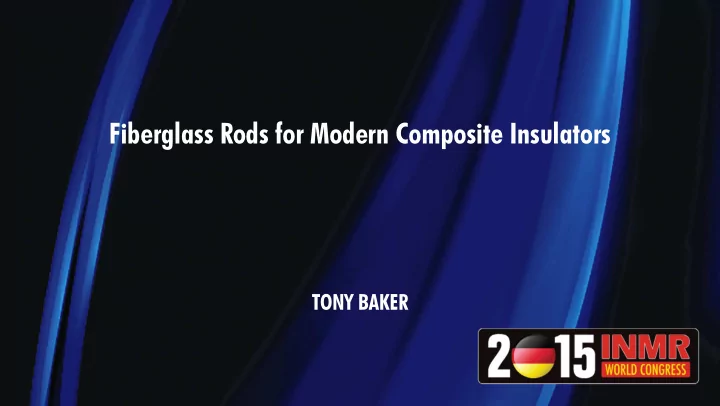

Fiberglass Rods for Modern Composite Insulators TONY BAKER
2015 INMR WORLD CONGRESS Fiberglass Rods for Modern Composite Insulators
Fiberglass Rods • Modern composite high voltage insulators • Mechanical characteristics • Electrical characteristics – Design tests – Routine tests • Brittle rod fractures – Causes & prevention – Verification of solution
Modern Composite Insulator Pultruded Resin Reinforced Fiberglass Rod Epoxy or polyester resin E-Glass Elastomeric Outer Housing Alumino-borosilicate electrical glass One-piece injection molded ECR-Glass (boron-free) Silicone Rubber Alumino-lime silicate electrical/chemical resistance glass Compressed-on End Fittings Moisture-proof Interfaces Extruded 6061-T6 Aluminum All rubber/rod/hardware interfaces Galvanized Ductile Iron Defined in ANSI C29 & CSA C411 Insulator Standards
Primary Mechanical Loads Suspensions / Dead-ends Line Posts Tension Cantilever Torsion
Rod Strength Characteristics RESIN POLYESTER EPOXY Strength Tension 110,000 psi 110,000 psi Torsion 11,100 psi 12,700 psi Bending 120,000 psi 130,000 psi
Rod Torsion Strength Diameter Ratio Torsion Strength Ratio 1/2 in. 1.00 1.00 5/8 in. 1.25 1.95 3/4 in. 1.5 3.37 Polyester resin Epoxy resin ~ 15% inc ncrease in n torsio ion str trength 5/8 in. rod 3/4 in. rod ~ 73% inc ncreas ase in n to torsio ion strength 20% inc ncrease in n diam ameter
Rod Dielectric Strength Tests ANSI, CSA, & IEC Design tests to demonstrate a rod has sufficient dielectric strength for use in high voltage insulators Test Detail Pass Criteria Dye Penetration 1% dye solution wick test > 15 min for 10 mm thick rod section Water Diffusion 30 mm rod section boiled in 1% salt Withstand 12 kV water for 100 hrs. for 1 minute
Routine Electrical Test Distance through solid dielectric material > half the dry arc distance Not specified in composite insulator standards
Routine Electrical Test One Manufacturer’s Routine Electrical Tests on Fiberglass Rods • 100 kV /lineal foot along the rod and circumferentially to it. • Pass/fail leakage current criteria varies with rod diameter.
Brittle Rod Fracture Brittle rod fracture : 345 kV Suspension insulator with epoxy cone end-fittings Ref. M. Kumosa, et al “Failure analysis of non - ceramic insulators Part I: brittle fracture characteristics”, IEEE Electrical Insulation Magazine, May/June 2005, Vol. 21, No. 3
Brittle Rod Fractures Stress corrosion cracking of the glass fibers in the rod due to: I. Exposure of the rod to water and mechanical stress. II. Associated with an acid , derived from the hardener, combined with water ingress and mechanical stress . III. Nitric acid formed in service and mechanical stress. Fiberglass rods must not be exposed to water or acids Ref. M. Kumosa, et al “Failure analysis of non - ceramic insulators Part I: brittle fracture characteristics”, IEEE Electrical Insulation Magazine, May/June 2005, Vol. 21, No. 3
Resistance to Nitric Acid Attack 19,430 psi 4-Point bending tests on fiberglass rods exposed to 1.2 pH Nitric acid Fiberglass Resin AE events E-glass (boron ) polyester 43,699 E-glass (boron) epoxy 1,435 ECR-glass (boron free, high seed) polyester 328 ECR-glass (boron free, high seed) epoxy 136 ECR-glass (boron free, low seed) epoxy 3.5 Ref. L.S. Kumosa, et al, “Resistance to brittle fracture of glass reinforced polymer composites used in composite (non- ceramic) insulators”, IEEE Trans on Power Delivery Vol. 20, No.4, Oct. 2005
Fiberglass Electrical Strength E-glass ECR-glass - high seed count Ref. M. Kumosa, et al “Failure analysis of non -ceramic insulators Part II: The brittle fracture model and failure prevention”, IEEE Electrical Insulation Magazine, July/August 2005, Vol. 21, No. 4
Thermo-mechanical Load Temperature Cycle Test CSA C 411.4 Composite Suspension Insulator Standard
Moisture Proof Design High pressure washing composite transmission suspension insulator .
Long-term Immersion/Load Test Suspension insulator with encapsulated end-fittings subject to continuous 400 hour tension load at 50% SML .
Long-term Immersion/Load Test Suspension end-fitting encapsulated in liquid fuchsine dye
Long-term Immersion/Load Test Interfaces after 400- hour tension-dye encapsulation tests showing no dye in seal area.
Summary • High inter-laminar shear stress applications Epoxy resin fiberglass rods. • Torsion loading Diameter more important than resin type. • Rod dielectric strength Tests are indirect, but routine electrical tests possible. • Brittle rod fractures Stress corrosion cracking of small diameter fiberglass rods from exposure to nitric acid formed in service. • Prevention of brittle rod fractures: • Entire composite insulator assembly must be moisture proof in service. • Boron – free ECR-glass, epoxy resin fiberglass rods required. • But must also be low-seed ECR glass. • Moisture-proof tests: • Thermo-mechanical load temperature cycle test. • Long-term immersion/load test.
Recommend
More recommend